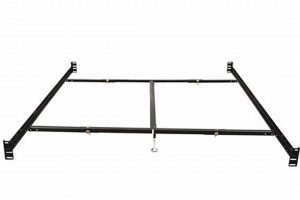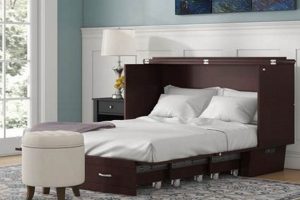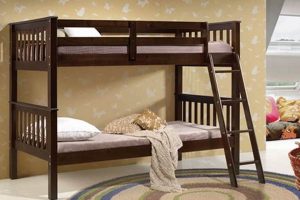A specialized support surface, typically constructed from durable materials like PVC or nylon, utilizes interconnected air chambers to distribute pressure. Designed as an overlay or replacement for standard innerspring surfaces, this device aims to mitigate the risk of pressure injuries. As an example, a patient confined to a hospital bed for extended periods can benefit from the alternating pressure provided, which cyclically inflates and deflates different sections of the device.
The implementation of these support systems is crucial in modern healthcare settings due to their potential to improve patient outcomes and reduce healthcare costs associated with pressure ulcer treatment. Historically, efforts to address pressure injuries have evolved from simple padding to sophisticated technologies that actively manage pressure and microclimate. This evolution reflects a growing understanding of the complex interplay between pressure, shear, friction, and moisture in the development of skin breakdown.
The ensuing discussion will delve into various types of these support surfaces, examining their mechanisms of action, clinical applications, advantages, and limitations. Furthermore, it will consider factors influencing selection criteria, including patient-specific needs, cost-effectiveness, and ease of use for caregivers. The exploration will also touch upon emerging technologies and future directions in the field of pressure injury prevention.
Guidance on Utilization
The following provides essential guidance for effectively implementing specialized support surfaces in a clinical setting to optimize patient comfort and minimize the risk of pressure injuries.
Tip 1: Proper Weight Distribution: Ensure the patient’s weight is evenly distributed across the entire surface of the air mattress. Avoid situations where bony prominences, such as the sacrum or heels, bear excessive pressure.
Tip 2: Regular Inspection: Conduct routine visual inspections of the surface for any signs of damage, leaks, or deflation. Promptly address any identified issues to maintain optimal performance.
Tip 3: Adherence to Weight Limits: Do not exceed the manufacturer-specified weight limit for the selected model. Exceeding this limit can compromise the mattress’s integrity and effectiveness.
Tip 4: Monitoring Inflation Levels: Regularly verify that the air chambers are inflated to the appropriate pressure levels as indicated by the manufacturer’s guidelines. Adjustments may be necessary based on the patient’s weight and body composition.
Tip 5: Skin Assessment: Implement a comprehensive skin assessment protocol to identify early signs of pressure injury development. Pay particular attention to areas exposed to prolonged pressure.
Tip 6: Education and Training: Provide thorough training to all caregivers on the proper use, maintenance, and troubleshooting of these specialized support surfaces. Effective operation is essential for maximizing patient benefit.
Tip 7: Use of Protective Barriers: Consider utilizing moisture-wicking underpads and specialized dressings to minimize skin exposure to moisture, a contributing factor to pressure injury formation.
By adhering to these practical guidelines, healthcare professionals can significantly enhance the effectiveness of these support surfaces, contributing to improved patient safety and reduced incidence of pressure-related complications.
The information above provides a foundation for the responsible and effective use of specialized support surfaces. The final section will synthesize the main points and consider future trends.
1. Pressure Ulcer Prevention
Pressure ulcer prevention is an integral component of patient care, particularly for individuals with limited mobility or those confined to hospital beds for extended periods. The implementation of specialized support surfaces, commonly referred to as “air mattress for hospital beds”, is a critical strategy in mitigating the risk of these debilitating injuries.
- Pressure Redistribution
The primary mechanism by which these support surfaces contribute to pressure ulcer prevention is through pressure redistribution. By utilizing interconnected air chambers, the mattress dynamically adjusts pressure across the patient’s body, minimizing prolonged compression on bony prominences such as the sacrum, heels, and hips. Studies have demonstrated that this constant redistribution reduces the incidence of tissue ischemia, a key factor in ulcer development. For example, an alternating pressure mattress cycles pressure points, preventing sustained compression on any single area.
- Microclimate Management
Elevated skin moisture increases the risk of pressure ulcer formation. These devices often incorporate features designed to manage the microclimate around the patient’s skin. Some models feature low-air-loss technology, which gently circulates air to reduce moisture accumulation and maintain a drier skin surface. In a practical setting, this technology translates to a reduction in maceration, thereby preserving skin integrity. This is crucial for patients with incontinence or excessive perspiration.
- Shear Force Reduction
Shear force, which occurs when adjacent layers of tissue slide relative to each other, is another significant contributor to pressure ulcer development. Certain air mattress designs incorporate features that minimize shear. For example, some surfaces are designed with a low-friction top sheet or a segmented air cell design that allows the mattress to conform to the patient’s body movements, reducing the forces that can damage delicate skin and underlying tissues. This is especially pertinent when repositioning a patient within the bed.
- Patient Positioning and Support
Specialized support surfaces facilitate proper patient positioning, which is essential for pressure ulcer prevention. The adjustable nature of these devices allows caregivers to optimize body alignment and reduce pressure on vulnerable areas. For instance, a mattress can be configured to elevate the heels slightly off the surface, effectively offloading pressure and preventing heel ulcers, a common complication in immobilized patients. This adjustable support contributes significantly to a comprehensive pressure ulcer prevention plan.
In summary, the effective deployment of “air mattress for hospital beds” encompasses multiple facets crucial for pressure ulcer prevention, ranging from active pressure redistribution and microclimate control to shear force reduction and optimized patient positioning. These features contribute synergistically to a comprehensive strategy designed to protect patient skin integrity and improve overall clinical outcomes. The careful selection and appropriate use of these specialized support surfaces remain paramount in the management of patients at risk for pressure injuries.
2. Patient Comfort Enhancement
Patient comfort enhancement represents a critical consideration in the selection and utilization of specialized support surfaces, commonly known as “air mattress for hospital beds.” The inherent design and functionalities of these surfaces directly influence a patient’s subjective experience and overall well-being during periods of prolonged immobility. A comfortable patient is more likely to cooperate with treatment plans and experience reduced levels of anxiety and discomfort.
- Pressure Point Relief
A primary mechanism by which these mattresses enhance comfort is through the alleviation of concentrated pressure points. Traditional innerspring surfaces often lead to localized pressure on bony prominences, resulting in discomfort and potential skin breakdown. “Air mattress for hospital beds”, conversely, employ adjustable air chambers to distribute weight more evenly, minimizing pressure on specific areas. As an example, a patient with sacral pain may experience significant relief from the alternating pressure cycles that redistribute pressure away from the affected area.
- Temperature Regulation
Temperature regulation is another facet influencing comfort. Patients confined to bed for extended periods may experience difficulties maintaining a comfortable body temperature, leading to either overheating or chills. Certain “air mattress for hospital beds” incorporate features such as low-air-loss technology, which facilitates air circulation and helps regulate the microclimate surrounding the patient’s skin. This prevents excessive moisture buildup and contributes to a more stable and comfortable temperature environment.
- Noise Reduction
The noise generated by the inflation and deflation mechanisms of some “air mattress for hospital beds” can negatively impact patient comfort and sleep quality. Manufacturers are increasingly focusing on designing quieter systems that minimize noise disruption. Advanced pump technologies and sound-dampening materials contribute to a more peaceful and restful environment for the patient, crucial for recuperation and overall well-being. A less intrusive device aids in promoting undisturbed sleep cycles.
- Surface Conformity
The ability of the mattress surface to conform to the patient’s body contours is a significant determinant of comfort. Rigid or unyielding surfaces can create pressure points and discomfort, particularly for individuals with irregular body shapes or skeletal deformities. “Air mattress for hospital beds” with adjustable air chambers can be customized to provide optimal support and conformity, accommodating individual patient needs and preferences. For instance, a patient with scoliosis can benefit from a mattress that adapts to their spinal curvature, providing targeted support and pressure relief.
These diverse aspects of patient comfort, each meticulously addressed within the design and functionality of specialized support surfaces, underscore the importance of considering “air mattress for hospital beds” as integral components of a comprehensive patient care strategy. By prioritizing comfort, healthcare providers can significantly improve patient compliance, reduce discomfort, and foster a more conducive environment for healing and recovery.
3. Adjustable Air Chambers
Adjustable air chambers represent a core technological feature of “air mattress for hospital beds,” serving as the primary mechanism for pressure redistribution and customized support. The presence, configuration, and control of these chambers directly impact the effectiveness of the mattress in preventing pressure injuries and enhancing patient comfort. These chambers, typically constructed from durable polymers, are interconnected and selectively inflated or deflated to alter the support surface’s characteristics. Without adjustable air chambers, a mattress lacks the dynamic capability to respond to individual patient needs and would largely function as a static support, mitigating, but not actively preventing, pressure ulcer formation. Consider a patient with varying degrees of edema in different limbs; adjustable air chambers allow for differential pressure settings to accommodate the fluid shifts, preventing excessive pressure on already compromised tissues. This represents a distinct advantage over traditional static mattresses.
The functionality of adjustable air chambers extends beyond simple pressure relief. Complex algorithms and control systems govern the inflation and deflation cycles, enabling alternating pressure therapy or targeted pressure reduction in specific zones. Real-world examples demonstrate this precision: a patient recovering from a hip fracture may benefit from reduced pressure beneath the greater trochanter, facilitated by strategically deflated air chambers. Furthermore, some advanced systems incorporate sensors that detect patient movement and adjust chamber pressures automatically, optimizing support and comfort in real-time. This active adaptation contrasts sharply with manually adjusted systems that require constant monitoring and intervention by healthcare staff. The ability to dynamically respond to changes in a patients condition is paramount in preventing the onset of pressure injuries, further emphasizing the value of adjustable air chambers.
In summary, adjustable air chambers are not merely an added feature but an indispensable component of “air mattress for hospital beds.” Their ability to provide dynamic pressure redistribution, customized support, and responsive adjustments significantly contributes to pressure injury prevention and patient comfort. Challenges remain in optimizing control algorithms and reducing system noise; however, the practical significance of this technology remains undeniable. Future advancements will likely focus on improved sensor integration, self-adjusting capabilities, and enhanced durability, further solidifying the role of adjustable air chambers in modern hospital bed technology.
4. Weight Capacity Standards
Weight capacity standards are a critical component in the effective and safe use of air mattresses designed for hospital beds. The weight capacity rating indicates the maximum weight the mattress can support while maintaining its intended functionality, including pressure redistribution and structural integrity. Exceeding this limit can result in compromised performance, leading to inadequate pressure relief and an increased risk of pressure injuries. A direct correlation exists between adhering to weight capacity standards and minimizing patient risk. For instance, an obese patient placed on a mattress with an insufficient weight rating may experience bottoming out, where the air chambers are fully compressed, negating any pressure redistribution benefits. Real-world examples reveal that failure to heed these standards frequently results in premature mattress failure and potential patient harm. This highlights the practical significance of understanding and respecting these limitations.
Beyond patient safety, adherence to weight capacity standards directly impacts the lifespan and cost-effectiveness of air mattresses. Overloading a mattress can cause undue stress on the air chambers, seams, and support
ing structures, accelerating wear and tear and ultimately shortening the product’s lifespan. This, in turn, necessitates more frequent replacements, increasing healthcare facility costs. Furthermore, proper weight management in conjunction with appropriate mattress selection can contribute to reduced maintenance and repair expenses. For example, a bariatric-rated mattress, specifically designed to accommodate higher weights, offers a more durable and reliable solution for heavier patients, preventing common issues associated with using standard mattresses beyond their intended limits. This proactive approach demonstrates a commitment to both patient well-being and responsible resource allocation.
In summary, weight capacity standards are not merely arbitrary numbers but essential guidelines for ensuring the safe and effective use of “air mattress for hospital beds.” Ignoring these standards can lead to compromised patient outcomes, increased healthcare costs, and premature equipment failure. Healthcare providers must prioritize proper patient assessment and mattress selection based on weight capacity ratings to optimize pressure injury prevention and maximize the lifespan of these specialized support surfaces. Challenges remain in educating staff about the importance of these standards and ensuring consistent adherence; however, the practical significance of this understanding is undeniable for both patient safety and financial stewardship.
5. Cleanability and Hygiene
The intersection of cleanability and hygiene with specialized air mattresses used in healthcare settings is a critical determinant of infection control and patient safety. These mattresses, designed to mitigate pressure injuries, are inherently subject to contamination from bodily fluids, microorganisms, and environmental debris. Inadequate cleaning and disinfection protocols directly compromise the hygienic integrity of the mattress, creating a potential reservoir for pathogens and increasing the risk of healthcare-associated infections (HAIs). The porous nature of certain mattress materials and the intricate design of air chambers amplify the challenge of achieving thorough decontamination. For example, a mattress exposed to Clostridium difficile spores during a patient stay can remain a source of infection for subsequent occupants if not properly disinfected. The selection of appropriate cleaning agents and methodologies is therefore paramount in minimizing the bioburden on these surfaces.
The practical application of effective cleaning protocols requires adherence to manufacturer guidelines and implementation of standardized procedures. Frequent cleaning, particularly after each patient use and following any visible contamination, is essential. The use of hospital-grade disinfectants with proven efficacy against relevant pathogens, including bacteria, viruses, and fungi, is mandatory. Furthermore, meticulous attention to detail is required during the cleaning process, ensuring that all surfaces, seams, and crevices are thoroughly treated. Certain mattress designs facilitate improved cleanability through features such as impermeable covers, welded seams, and antimicrobial treatments. These design considerations directly contribute to reducing the risk of pathogen colonization and simplifying the disinfection process. Real-world examples demonstrate the benefits of proactive cleaning: hospitals with rigorous disinfection protocols exhibit significantly lower rates of HAIs compared to those with lax or inconsistent practices.
In summary, the symbiotic relationship between cleanability, hygiene, and “air mattress for hospital beds” demands unwavering attention to detail and adherence to evidence-based practices. Compromised cleanability directly translates to increased infection risk, potentially negating the benefits of pressure injury prevention. Challenges remain in ensuring consistent compliance with cleaning protocols and in selecting mattresses with inherently superior cleanability characteristics. However, the practical significance of prioritizing cleanability and hygiene is undeniable in maintaining a safe and infection-free healthcare environment, underscoring its vital role in holistic patient care.
Frequently Asked Questions
This section addresses common inquiries and clarifies misconceptions regarding the usage, maintenance, and suitability of specialized air mattresses designed for hospital beds.
Question 1: What are the primary benefits derived from using an air mattress on a hospital bed?
The primary benefits include pressure redistribution, which minimizes the risk of pressure injuries; enhanced patient comfort through adjustable support; and, in some models, microclimate management to reduce skin maceration.
Question 2: How frequently should an air mattress for hospital beds be cleaned?
The mattress should be cleaned and disinfected after each patient use and whenever visible contamination occurs. Adherence to manufacturer’s guidelines regarding approved cleaning agents is crucial.
Question 3: Are all air mattresses for hospital beds suitable for all patients?
No. Patient-specific factors, such as weight, body mass index, skin condition, and medical history, must be considered when selecting an appropriate mattress. Weight capacity limits should never be exceeded.
Question 4: What is the expected lifespan of an air mattress used in a hospital setting?
The lifespan varies depending on the quality of the mattress, frequency of use, and adherence to maintenance protocols. Regular inspections for damage are essential to ensure continued efficacy and safety.
Question 5: Can an air mattress completely eliminate the risk of pressure injuries?
While air mattresses significantly reduce the risk, they do not guarantee complete prevention. Regular skin assessments, proper patient positioning, and adequate nutrition remain critical components of a comprehensive pressure injury prevention strategy.
Question 6: What are the potential drawbacks associated with the use of air mattresses?
Potential drawbacks may include noise generated by the air pump, the need for a power source, and the risk of mattress deflation due to leaks or mechanical failure. Contingency plans should be in place to address these possibilities.
In summary, while air mattresses offer significant benefits in pressure injury prevention and patient comfort, their effective use requires careful consideration of individual patient needs, adherence to maintenance protocols, and integration within a comprehensive care plan.
The following section provides a comparative analysis of available models.
Air Mattress for Hospital Beds
This exploration has detailed various facets of air mattresses designed for hospital beds, underscoring their importance in modern healthcare. Key considerations include pressure ulcer prevention, patient comfort enhancement, the functionality of adjustable air chambers, adherence to weight capacity standards, and stringent hygiene protocols. Each element contributes significantly to the efficacy of these specialized support surfaces in promoting positive patient outcomes and reducing healthcare-associated complications.
Continued research and development in this domain remain crucial to optimize air mattress technology, improve patient safety, and enhance the overall quality of care. Healthcare facilities must prioritize informed decision-making, rigorous implementation of best practices, and ongoing monitoring to ensure the re
sponsible and effective use of these essential medical devices.


![Finding the Perfect 3/4 Mattress for Antique Beds - [Bed Size Guide] Organic & Natural Mattress Buyer’s Guide: Non-Toxic Sleep Solutions Finding the Perfect 3/4 Mattress for Antique Beds - [Bed Size Guide] | Organic & Natural Mattress Buyer’s Guide: Non-Toxic Sleep Solutions](https://mattressworldpa.com/wp-content/uploads/2025/07/th-7119-300x200.jpg)



![Quick Air Bed Mattress Repair Kit: [Brand] Fixes Leaks! Organic & Natural Mattress Buyer’s Guide: Non-Toxic Sleep Solutions Quick Air Bed Mattress Repair Kit: [Brand] Fixes Leaks! | Organic & Natural Mattress Buyer’s Guide: Non-Toxic Sleep Solutions](https://mattressworldpa.com/wp-content/uploads/2025/07/th-7115-300x200.jpg)
